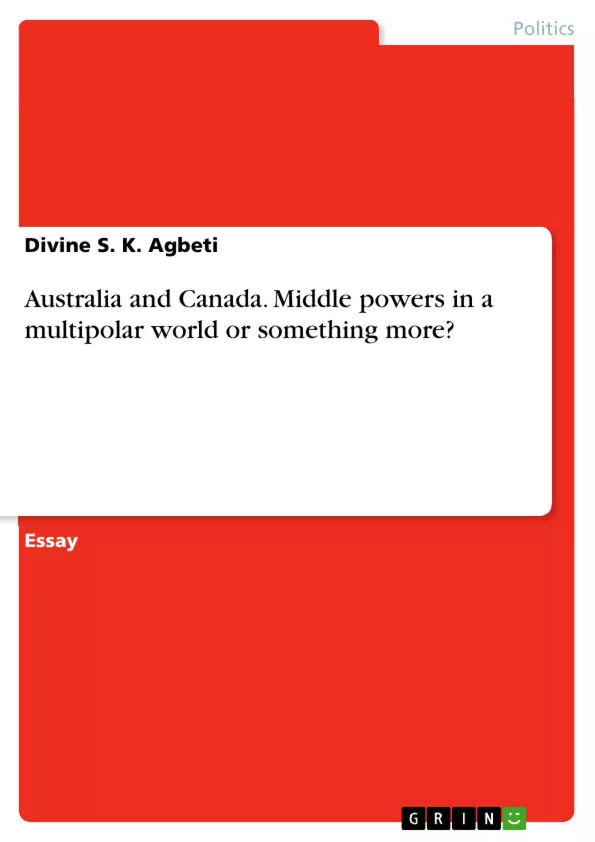The term “middle power” has been consistently used in international relations and foreign policy analysis. However, scholars argue that it remains a “deceptively ambiguous” term (Chapnick, 1999, pp. 73-74). Australia and Canada among other nations constantly project themselves as middle powers in the world, and the leaders of these countries always express
the significance of their role as middle powers in global affairs. Nevertheless, this paper observes that the term “middle power” is relative because states classified as middle powers in one approach could be small powers in another, and are dependent on their relative capacity to contribute to a given situation.
This paper adopts a comparative analysis of Australia and Canada’s foreign policy ambitions, and examines whether either or both countries befit a middle power status on the world stage.
Employing Cooper, Higgott and Nossal’s “behavioural” approach, the paper contends that Australia and Canada are middle powers in a multipolar world; taking into account the relative decline of US hegemony and relative rise of
China and others such as the BRICS. The paper demonstrates that Australia and Canada’s middle power diplomacies sometimes adopt a coalition-building with other “like-minded” countries as a key feature that distinguishes them from other middle powers.
The study is divided into three sections. The first section will establish the meaning and characteristics of a middle power. The second section seeks to investigate the agencies and structures that enable or limit a middle power’s foreign policy ambitions. The final section will conduct a comparative analysis of the middle power status of Australia and Canada.
Inhaltsverzeichnis (Table of Contents)
- Abstract
- Introduction
- What is a middle power?
- Agencies/Structures that influence the foreign policy behaviour of middle power states - Australia and Canada
- Comparative analysis of Australia and Canada as Middle Powers
- Australia
- Canada
- Conclusion
- Bibliography
Zielsetzung und Themenschwerpunkte (Objectives and Key Themes)
This paper examines Australia and Canada, two countries often categorized as "middle powers," and investigates whether their foreign policy actions align with this designation. It particularly focuses on the implications of a multipolar world, considering the relative decline of US dominance and the rise of powers like China and the BRICS nations.
- Ambiguity and relativity of the "middle power" concept
- Comparative analysis of Australia and Canada's foreign policy ambitions
- Influence of international system structure on middle power behavior
- The significance of coalition-building in middle power diplomacy
- The role of middle powers in maintaining international order
Zusammenfassung der Kapitel (Chapter Summaries)
- Introduction: The paper begins by introducing the concept of "middle power" and its ambiguity. It then focuses on Australia and Canada, highlighting their self-proclaimed middle power status. The paper aims to analyze whether their actions reflect this designation, particularly in a multipolar world.
- What is a middle power?: This section explores the various interpretations of the term "middle power." It examines different approaches to defining middle power status, including the "positional" approach based on quantifiable attributes and the "behavioural" approach focusing on foreign policy actions.
- Agencies/Structures that influence the foreign policy behaviour of middle power states - Australia and Canada: This chapter delves into the agencies and structures that shape the foreign policy ambitions of middle powers, particularly focusing on Australia and Canada. It investigates the factors that enable or limit their actions on the world stage.
Schlüsselwörter (Keywords)
The primary focus of this paper centers on the concept of "middle power" and its application to Australia and Canada. It explores the ambiguity of the term, analyzes the influence of a multipolar world on middle power behavior, and examines the significance of coalition-building and international order maintenance in their foreign policy actions. Key concepts include "positional" and "behavioural" approaches to defining middle powers, relative capacity, foreign policy ambitions, coalition-building, and the role of middle powers in international order.
- Quote paper
- Divine S. K. Agbeti (Author), 2014, Australia and Canada. Middle powers in a multipolar world or something more?, Munich, GRIN Verlag, https://www.grin.com/document/307189



